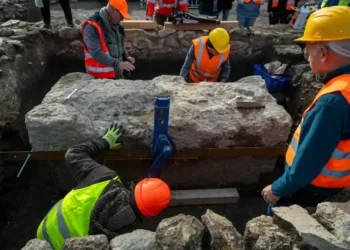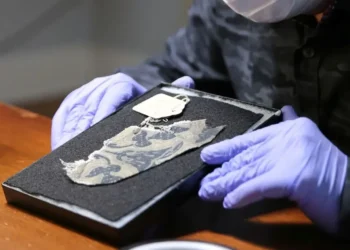Archaeologists Discover 43,000-Year-Old Neanderthal Fingerprint with Help from Forensic Police
In a remarkable crossover between archaeology and modern crime-solving, researchers in central Spain have uncovered what could be the oldest complete human-like fingerprint ever found in Europe — and it may belong to a Neanderthal.
The extraordinary discovery was made at the San Lázaro rock shelter in Segovia, a site believed to have been home to Neanderthals tens of thousands of years ago. Nestled under nearly five feet of sediment, archaeologists unearthed an unusual quartz-rich pebble marked with a striking red dot—a feature that immediately caught their attention.
A Pebble With a Secret
“When we first saw it, we were all gathered around the stone, thinking, ‘It looks like a face,’” recalled María de Andrés Herrero, a professor of prehistory at the Complutense University of Madrid and lead author of the study. What made this find particularly intriguing was that, unlike other tools or objects from the site, this pebble didn’t seem to serve any practical function.
Carbon dating revealed that the artifact is around 43,000 years old, and researchers believe it was deliberately brought to the shelter from a nearby riverbed. What they didn’t expect was that the red pigment on the rock would hold something even more astonishing: a human fingerprint, invisible to the naked eye.
Calling in the Crime Scene Experts
To get to the bottom of the mystery, Herrero’s team turned to an unlikely partner — Madrid’s forensic police, experts in crime scene investigations. At first, the officers were skeptical. “They’re used to analyzing fingerprints that are hours or days old — not ones that are over 40,000 years old,” Herrero said with a laugh.
But using forensic imaging techniques and multispectral analysis, the team was able to detect the ridge patterns of a fingerprint embedded in the red ocher pigment — confirming that a Neanderthal adult male likely pressed his ocher-covered fingertip onto the pebble.
To ensure the print didn’t belong to a modern-day researcher, forensic specialists carefully ruled out all members of the excavation team.
A Message from the Distant Past?
The presence of a fingerprint on a pigment-marked pebble isn’t just a forensic curiosity — it may signal something far more profound: Neanderthal symbolic behavior.
Researchers noted that the red ocher — a type of natural clay pigment — was intentionally applied, and the placement of the dot on the pebble could even represent a face, with the rock’s natural hollows forming what looks like eyes, a mouth, and a chin. The red dot may have symbolized a nose, potentially making this one of the earliest examples of representational art.
“This isn’t just a smudge — it was intentional,” Herrero explained. “It shows that a human mind was behind this, someone capable of abstract thinking and imagination.”
Shifting the Image of Neanderthals
For years, Neanderthals were portrayed as brutish and primitive. But discoveries like this are challenging that stereotype. This find adds to a growing body of evidence — from cave paintings to personal ornaments — that Neanderthals engaged in symbolic thought and possibly artistic expression.
“This is yet another example of the emerging data that reveal a Neanderthal visual culture,” said Paul Pettitt, a Paleolithic archaeology professor at Durham University. “It’s a clear, unequivocal instance of their use of pigment to leave body marks on objects — something we once thought only modern humans did.”
Science at the Intersection
The research, published May 24 in the journal Archaeological and Anthropological Sciences, emphasizes the power of collaboration between disciplines. Herrero believes forensic science and archaeology are beginning to unlock new doors to the past.
“We’re planning to search for more ‘invisible artifacts,’” she said. “These are objects that may look ordinary, but contain stories waiting to be discovered with the right tools. Forensics is opening a new window into human history.”
In a time when artificial intelligence and cutting-edge tech dominate headlines, it’s poetic that a 43,000-year-old fingerprint could connect us more deeply to our ancient cousins — and remind us that the capacity for creativity and meaning might go back much further than we ever imagined.
This article was rewritten by JournosNews.com based on verified reporting from trusted sources. The content has been independently reviewed, fact-checked, and edited for accuracy, neutrality, tone, and global readability in accordance with Google News and AdSense standards.
All opinions, quotes, or statements from contributors, experts, or sourced organizations do not necessarily reflect the views of JournosNews.com. JournosNews.com maintains full editorial independence from any external funders, sponsors, or organizations.
Stay informed with JournosNews.com — your trusted source for verified global reporting and in-depth analysis. Follow us on Google News, BlueSky, and X for real-time updates.














